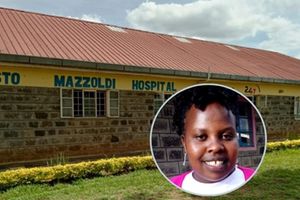
Principal Secretary, State Department for Medical Services Harry Kimtai (left) addressing journalists on the Social Health Authority (SHA) rollout at SHA building, Nairobi on October 6, 2024.
The government rolled out the Social Health Insurance Fund (SHIF) three months after signing a deal with a Safaricom-led consortium for an elaborate electronic information system that was to be developed over two years.
This rushed implementation is the reason the new Sh104.8 billion Integrated Healthcare Information Technology System (IHTS), which is largely still under development, is having challenges.
With the deactivation of the National Hospital Insurance Fund (NHIF) system on October 1, the technical hiccups experienced with the new system have caused untold suffering to thousands of patients as hospitals unable to process claims demand cash.
Nation.Africa has also learnt from senior officials at the Digital Health Agency (DHA) that when the IHTS went live this month, only five out of 17 components were functioning although even those in operation “were not at 100 percent.”
Former Kenya Medical Practitioners, Pharmacists and Dentists Union (KMPDU) secretary-general Dr Chibanzi Mwachonda said that the biggest challenge since the roll-out of SHIF has been that the new system is dysfunctional and hospitals have capitalised on the difficulties to force patients to pay in cash.
In an exclusive interview with Nation.Africa on Friday, developers at Safaricom confirmed that the IHTS which has 17 components requires two years to build, and as per the deal that was signed, it was scheduled to be launched in 2026, a year before President William Ruto winds up his first term. The hasty rollout is the reason it is not working perfectly as the government promised.
Digital health expert Dr Job Nyameino, who leads Safaricom’s team of nine experts that include doctors and software engineers, said that their agreement with the Ministry of Health was to develop the system from scratch for a period of two years after which the telco giant would take 10 years to roll out and implement.
“We are to develop it for two years then implement the roll out for the next 10 years before handing it over to the government,” Dr Nyameino said.
He explained that, so far, they have built around eight components that they are fine-tuning.
“The Ministry of Health engaged Safaricom through a specially permitted procurement (SPP) on provision of healthcare information technology for universal health coverage (UHC),” he stated and detailed the scope of the project.
Digital health infrastructure
The team is supposed to deliver a baseline assessment of the current digital health infrastructure, digitisation of primary care networks and referral hospitals, development of Kenya’s Health Information Exchange, which would facilitate access to records.
The project also entails development of the national eClaims platform, SHA’s enterprise resource planning (ERP), a national logistic information management system, a national eLearning platform, a data lake analytic platform, clinical decision support system (CDSS), national telemedicine platform, emergency response platform with an ambulance component within it, a licensing and quality management platforms.
“We have also been tasked to deliver Primary Care Network (PCN), Level 2-4 facilities including endpoints, infrastructure and connectivity, build health data centres, security operation center, network operations center, project management and customer education,” Dr Nyameino said.
Collectively, the 17 layers or components are supposed to be fitted under one system, the IHTS, which the government has touted as Kenya’s Health Superhighway.
But the premature rollout, it would appear, has led to bottlenecks at hospitals with the patients bearing the brunt of the technical glitches.
The most affected are patients seeking dialysis, chemotherapy and lifesaving surgeries, as they are forced to dig deeper into their pockets.
Preliminary stages like registration on the government’s ‘Afyangu’ platform via afyangu.go.ke is still a problem.
Last Friday at 11.13am Nation.Africa tried to register and by Sunday afternoon, the verification code was yet to show up.
‘Afyangu’ is supposed to simplify medical records management, insurance tracking and health monitoring.
How did the country get here?
It all started in August when Medical Services Principal Secretary Harry Kimtai showed up at Safaricom and asked the telco to build the IHTS in three months, a task five other telcos, local and international, had said was impossible.
But why was the government in a hurry to roll out the premature system despite pleas by healthcare professionals and Kenyans?
In June, the then Health Cabinet Secretary Susan Nakhumicha announced that Kenyans would register for SHIF effective on July 1.
The roll-out date would later be moved to October after the previous developer’s government told the Ministry of Health officials it was impossible to have the system up and running in three months.
Unlike the other five telcos that developed cold feet, Safaricom, which had now been seen as the last resort and better option to deliver on such short notice, agreed to the deal.
Pressure to have the system that was still at an infancy stage of development rolled out came from higher quarters, Health ministry officials told Nation.Africa
“Our projections indicated billions of shillings would be made which is why the government wants to make money as soon as possible,” a senior official at the ministry, who is not authorised to speak on the matter, said.
According to the ministry, the new system is projected to raise Sh133 billion annually, a significant increase from Sh78.8 billion that was collected by NHIF in the financial year 2023/2024.
While responding to questions, Dr Samson Kuhora, the Head of Design and Benefits Management at NHIF, said that their estimates assume that 85 percent of the population will be reached once the new SHIF system is fully functional and at least 70 percent of the disease burden will be covered.
“This is why I mentioned the allocation from Treasury (Sh61 billion plus Sh 107 billion) to implement the UHC Essential Benefit package is what will make the difference,” he told Nation.Africa.
On Friday, we found the Safaricom team that has been burning the midnight oil five floors above Safaricom Care Centre, deep at work.
Primary Care Network
The Primary Care Network (PCN) Model has 315 PCNs across the 47 counties, seven per county.
“The PCN consists of facilities and administrative committees and is developed as a referral system that seeks to ease pressure on advanced health systems with PCN focus being preventive care,” Dr Nyameino said, while explaining how complex the system they are building is.
They are designing a data collection system specifically designed to support planning, management and decision-making in all levels of health facilities around the country (HMIS).
This is then combined with a system that can store medical records for each Kenyan known as electronic medical records (EMR) while at the same time including an Enterprise Resource Planning (ERP) component that will help manage the processes and resources within all these health facilities.
“In there we also have to incorporate the Kenya Electronic Community Health Information System (eCHIS), Kenya Health Information Systems (KHIS) which is an open-source, web-based software platform for data collection, management, and analysis as well as design the health information exchange system,” Dr Nyameino added.
The health information exchange consists of message queue adapters and database adapters, client, healthcare professionals and facility registries as well as a ‘shared health records component’.
“We are also building a national terminology services component whereby the system has to recognise medical terminologies keyed in so that it processes them accurately,” he explained.
The Safaricom lead expert on the project said they are working on the FHIR® (Fast Healthcare Interoperability Resources) standard which defines how healthcare information can be exchanged between different computer systems regardless of how it is stored in those systems.
“It allows healthcare information, including clinical and administrative data, to be available securely to those who have a need to access it, and to those who have the right to do so for the benefit of a patient receiving care,” he explained. He highlighted that all hospital systems in the country will have to adopt FHIR® to connect to the health information exchange component.
On the licensing platform, Dr Nyameino said that it will facilitate licensing of professionals and facilities, reduce the administrative burden on physicians and ensure compliance with regulatory requirements.
The platform will be powered by the health professionals and facilities registries and will integrate with other government portals such as medical boards and accrediting bodies, to streamline the verification process for licenses.
It will also allow mapping and restricting the provision of services to licensed health professionals in a bid to protect Kenyans from quacks. The new e-claims system is more complex than what was under NHIF.











